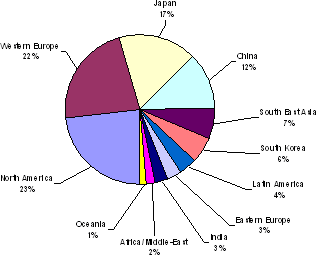Linux top OS in MIDs
Jun 13, 2008 — by Eric Brown — from the LinuxDevices Archive — 2 viewsLinux will be a top OS in MIDs (mobile Internet devices), suggests a report from Forward Concepts. The report, aimed at quantifying MID-related opportunities for chip makers, identifies TI and Qualcomm as well-positioned in an emergent market expected to reach 40 million unit shipments globally within four years.
Intel coined the term “MID” in April of 2007, when it launched the MID concept at its Beijing Developer's Conference. At the time, it projected a global market of 180 million units annually in the sector by 2010.
In its 206-page report, Forward Concepts is considerably less bullish. And, in a summary report highlighting key findings, the research firm suggests that Intel may not actually dominate the MID chip vendor, despite having “invented” the form-factor.
MIDs — a battleground for ARM vs. x86?
Forward Concepts forecasts MID shipment growth from 305,000 units in 2008 to 39.6 million units in 2012. For chip makers, that equates to growth from $29 million in 2008 to $2.6 billion in 2012, it reckons.

Mid chip market by region
(Source: Forward Concepts)
Among MID processor vendors, Intel is clearly a leading contender, with its Atom Z500 processor and SCH (system controller hub) integrated companion chip. However, Forward Concepts shies away from calling Intel a likely leader in the MID market, instead suggesting only that Intel “has a much better shot” in netbooks and UMPCs, larger device formats where “x86 compatibility is important,” according to the firm. (Intel has also launched an Atom N270 part that mates with more traditional two-chip chipsets, and targets netbooks and UMPCs.)
Among non-x86 chip vendors, Forward Concepts likes Texas Instruments (TI), which it notes has the largest share among stand-alone smartphone applications processor vendors. TI's latest offerings in the space include the Cortex-A8 based OMAP34xx, and its lower-volume, larger package OMAP35xx, soon to be available on a $150 Beagle development board.
Another strong contender, says Forward Concepts, is Qualcomm, which offers a SnapDragon application processor and “market-leading 3G wireless solutions.” Others to watch include Samsung, which announced an ARM-11 based application processor in February, and nVidia, presumably for its newly announced, and so far Windows-only, Tegra processor.
 Nokia's newest “MID” connects by WiMAX (Click for details) |
The MID format appears to be inspired in part by the success of Nokia's N800 line of Linux-based Internet Tablets, which have 4.3-inch 800×480 displays, a wide range of networking options, and a basis in the ARM architecture. All Nokia Linux tablet models so far have used Texas Instruments (TI) OMAP processors (OMAP2420s, in the current offerings).
Other findings — Linux the favorite?
The study suggests that Linux will be a leading OS for MIDs. Stated Will Strauss, president of Forward Concepts and editor of the report, “Linux will be popular in MIDs for its lower processing overhead and tighter OEM control.”
Strauss also observed, “We don't envision MIDs as ever employing Microsoft's Vista operating system. However, we believe that Microsoft has a MID play with future versions of Windows Mobile.”
Though not mentioned by Forward Concepts in its summary findings report, much work has been done to adapt Linux to small-format web tablets similar to MIDs. For ARM processors, there are quite a few relatively mature open source application stacks, including the Nokia-sponsored Maemo Project, Qtopia, Opie, GPE, Poky Linux, and a host of others. Meanwhile, full-fledged Ubuntu recently made its way onto a PDA.
For Atom, meanwhile, work is definitely underway. Intel sponsors a Moblin group aimed at providing free tools to software developers targeting Atom. And, commercial embedded Linux provider Wind River has jumped onboard energetically, announcing its Wind River Linux Platform for Mobile Internet Devices based in part on Moblin project software.
Availability
Authored by Forward Concepts senior analyst Satish Menon, the 206-page study, “Mobile Internet Device (MID) & Chip Market Opportunities,” includes 46 figures and 23 tables, says the research group. It covers MIDs and the integrated circuits that drive them, including application processors, digital basebands, RF transceivers and PAs, graphics chips and other coprocessors, imagers, touch-screen controllers. It also explores the role of peripheral chips like WiFi, WiMAX, GPS, Bluetooth, and mobile TV processors. More information on the study may be available here.
This article was originally published on LinuxDevices.com and has been donated to the open source community by QuinStreet Inc. Please visit LinuxToday.com for up-to-date news and articles about Linux and open source.